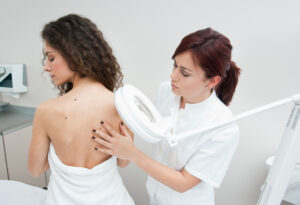How Often Should You Get Skin Cancer Screenings?
 Each year, millions of people in the United States are diagnosed with skin cancer. About 200,000 of these people are diagnosed with melanoma, the most serious form of skin cancer. With skin cancer being so prevalent, and early detection being the key to effective treatment, should everyone be lining up for regular skin cancer screenings?
Each year, millions of people in the United States are diagnosed with skin cancer. About 200,000 of these people are diagnosed with melanoma, the most serious form of skin cancer. With skin cancer being so prevalent, and early detection being the key to effective treatment, should everyone be lining up for regular skin cancer screenings?
Not necessarily, according to scientists. Because melanoma has a genetic component, it’s advised for people with a family history of malignant melanoma to have annual skin cancer screenings. You should also get an annual screening if you have other risk factors, like excessive sun exposure, precancerous lesions, prior exposure to radiation, or an abundance of moles. For most people, though, doctors don’t recommend routine screening.
How, then, can skin cancers be detected early enough to be effectively treated? One key is vigilant self-monitoring. If you regularly examine your own skin, you’ll be able to quickly recognize any changes. When you promptly show these changes to your primary care doctor, you’ll be referred to a dermatologist for further evaluation. This typically involves skin examination and a biopsy. An even more efficient way to detect skin cancer early is to develop a relationship with a dermatologist, so that you can skip the extra step of seeing a primary care doctor.
Of course, if you’ve never had a full-body screening, it’s good to schedule one with a dermatologist. That way, you’ll have a baseline so that it will be easier to notice if something changes. This kind of exam is usually done in about 10 minutes, and you’ll have to remove your clothes and wear a medical exam gown. Your dermatologist will check your skin thoroughly, going from head to toe and paying special attention to areas like your scalp, back, and buttocks, which are hard for you to see. The exam will cover every part of your body, with the possible exception of your genitalia, and the doctor will use a magnifying device called a dermatoscope. Your dermatologist will even look behind your ears and between your toes. If there are any suspicious spots, the doctor may biopsy them, removing part of each lesion and sending it to the lap to be analyzed.
If you’re looking for a dermatologist to help you care for your skin, Swinyer-Woseth Dermatology is committed to providing superior, professional care that’s practical, efficient, and compassionate. With over 30 years of experience providing dermatological services in Salt Lake City, we provide a variety of services, from cosmetic skincare to treatment for skin cancer. Our team of board-certified dermatologists, licensed cosmetic service providers, and friendly staff members is here to provide you the care you need in a comfortable, professional atmosphere. For more information, contact us through our website or call (801) 682-4715 today.
